David Albright and Andrea Stricker
- Since the 1970s, even before the revolution, Iran has sought access to the technology that would give it the option to build a nuclear bomb, should it believe its security situation requires it.
- Iran intensified its drive toward nuclear weapons in the 1980s during the Iran-Iraq War, following reports of an Iraqi clandestine nuclear program.
- Iranian leaders advanced Iran’s nuclear weapons program in the 1990s and early 2000s along with its civil nuclear program, using the latter as a symbol of national pride. They denied that Iran’s nuclear program ever had a military purpose despite substantial evidence possessed by the International Atomic Energy Agency and national intelligence agencies that it conducted nuclear weapons related work up until 2003 and perhaps continued certain activities afterwards.
- As a signatory to the Nuclear Non-Proliferation Treaty, Iran claims its nuclear program has always been purely for peaceful, energy and medical purposes.
- In November 2013, Iran signed an interim agreement limiting its nuclear programs - the Joint Plan of Action - with six world powers, the P5+1 (Britain, China, France Germany, Russia and the United States).
- On July 14, 2015, Iran and the P5+1 concluded a comprehensive deal with key provisions to limit Iran’s nuclear programs for 10 to 15 years and improve international transparency over its activities, in exchange for a removal of U.N., regional, and national sanctions. The agreement, known as the Joint Comprehensive Plan of Action (JCPOA) should go into effect sometime in mid-2016. Most analysts judge that substantial effort will need to be devoted to enforcing and maintaining the agreement and ensuring that Iran’s nuclear programs remain peaceful afterward.
Overview
A majority of the international community has been at odds with Iran over its nuclear program because of its history of concealing its nuclear activities, the possible military nature of some of these activities, and its building of facilities in secret. Many of Iran’s Arab neighbors, in addition to Israel, fear an Iranian nuclear bomb and could seek their own nuclear deterrent if Iran succeeds in acquiring nuclear weapons. Some countries in the Middle East may seek to duplicate Iran’s nuclear capabilities, including uranium enrichment capabilities, although these efforts would likely be subject to international inspections.
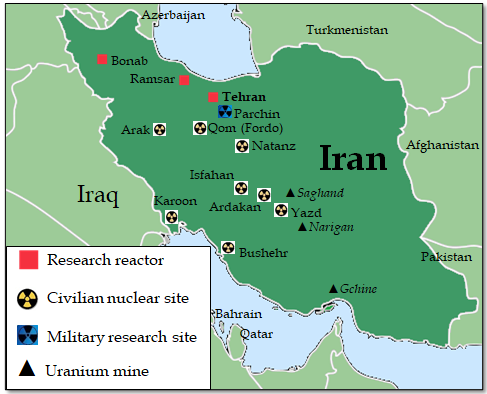 Iran initially constructed in secret its gas centrifuge uranium enrichment program, including a large centrifuge plant at Natanz, and a heavy water production plant at Arak. The existence of these major facilities was revealed in 2002, and they were then placed under International Atomic Energy Agency (IAEA) inspections. As part of settling international concern about its nuclear activities, Iran temporarily accepted more intrusive inspections by the U.N. nuclear watchdog. In 2006, Iran significantly reduced the inspection arrangements of the IAEA with its refusal to continue implementing the Additional Protocol to the Nuclear Non-Proliferation Treaty (NPT). This reversal prompted renewed concern that it could conduct significant nuclear activities in secret. The Protocol requires Iran to supply the IAEA with more detailed declarations of its nuclear activities and provide much greater access to nuclear sites than traditional safeguards. In response, the United Nations Security Council passed the first of several resolutions calling on Iran to suspend its activities and imposing sanctions on importing key goods to outfit its nuclear programs.
Iran initially constructed in secret its gas centrifuge uranium enrichment program, including a large centrifuge plant at Natanz, and a heavy water production plant at Arak. The existence of these major facilities was revealed in 2002, and they were then placed under International Atomic Energy Agency (IAEA) inspections. As part of settling international concern about its nuclear activities, Iran temporarily accepted more intrusive inspections by the U.N. nuclear watchdog. In 2006, Iran significantly reduced the inspection arrangements of the IAEA with its refusal to continue implementing the Additional Protocol to the Nuclear Non-Proliferation Treaty (NPT). This reversal prompted renewed concern that it could conduct significant nuclear activities in secret. The Protocol requires Iran to supply the IAEA with more detailed declarations of its nuclear activities and provide much greater access to nuclear sites than traditional safeguards. In response, the United Nations Security Council passed the first of several resolutions calling on Iran to suspend its activities and imposing sanctions on importing key goods to outfit its nuclear programs. Amplifying worries about Iran’s nuclear intentions, in September 2009, the United States, France, and Britain revealed the existence of a small, covert, and deeply buried uranium enrichment plant being built in Iran near the city of Qom. The United States suspected the facility could be used to quickly produce enough nuclear explosive material, or highly enriched uranium, for a nuclear weapon, in what is commonly called, “breakout.” Iran denied any military nuclear intentions for the site and placed it under IAEA safeguards.
In November 2011, the IAEA released a report listing areas in which it had evidence of Iran’s past and potentially ongoing work on nuclear weaponization and the development of nuclear warheads for missile delivery systems, or the so-called “possible military dimensions” (PMD) to its program. Iran and the IAEA agreed to a Roadmap alongside the JCPOA process, through which the IAEA will attempt to investigate the PMD matter and issue a full report of its findings by December 2015.
In November 2013, after a series of back channel talks between Iran and the United States, Iran and the P5+1 countries reached an interim agreement limiting Iran’s nuclear programs. The Joint Plan of Action (JPOA) restricted the amount of enriched uranium Iran could produce, reduced the number of centrifuges and sites it could operate, lengthened the time to “break out” —or the amount of time it would take Iran to produce one significant quantity of weapon-grade uranium for a nuclear weapon— and opened its program to additional transparency. The agreement was intended to freeze Iran’s nuclear progress while a longer term agreement to resolve the crisis could be negotiated.
In April 2015, a framework for a final deal was announced, and on July 14, 2015, a final deal was reached. The agreement will suspend and remove many key, stringent sanctions in exchange for a series of actions by Iran to scale back its nuclear program, address questions regarding past nuclear weapons related efforts and enhance inspectors’ ability to monitor its activities. The deal has been criticized because it does not explicitly require Iran to satisfy the IAEA’s concerns about past nuclear weapons work prior to the lifting of key sanctions. It also freezes Iran’s centrifuge program for only 10 years, allowing Iran to increase the size of its gas centrifuge program, slowly during years 11 through 13 and relatively rapidly afterwards. Iran has stated it plans to build a substantially larger gas centrifuge program than it currently has, once restrictions expire 15 years after implementation. After year 15, if Iran expands its program as planned, breakout times are expected to be reduced to a few days or weeks, versus several months as of 2015.
Evolution
Iran’s controversial nuclear program has evolved through at least seven phases.
Phase one: Beginnings 1950s-1960s
Iran first established its nuclear program in 1957, under Mohammad Reza Shah Pahlavi, with an agreement on nuclear cooperation with the United States under the Atoms for Peace program. In 1960, it purchased from the United States a small research reactor, which is located at the Tehran Nuclear Research Center. The reactor started in 1967. Iran signed the Nuclear Non-Proliferation Treaty in 1968, on the day it opened for signature. The United States provided highly enriched uranium fuel for the first several years of the reactor’s operation. (In the early 1990s, Argentina took over providing low enriched uranium fuel).
Phase two: Ambitious options 1970s
The shah established the Atomic Energy Organization of Iran (AEOI) in 1974 and announced plans to build 20 nuclear power reactors for energy production. The United States, France, and West Germany subsequently sought lucrative power reactor deals. In 1974, Iran signed a contract with the German firm Kraftwerk Union (a subsidiary of Siemens) to build two reactors at Bushehr. It also purchased nearly 600 tons of uranium yellowcake from South Africa.
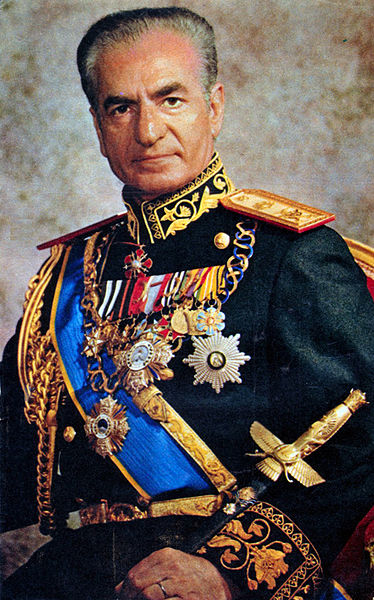 The shah wanted to keep open the option of developing nuclear weapons by seeking access to the full nuclear fuel cycle. The former head of AEOI, Akbar Etemad, revealed to Le Figaro in 2003 that he tasked a special research team with “giv[ing] the country access to all technologies, giving the political decision-makers the possibility of making the appropriate decision and doing so while time permitted them to build a bomb if that is what was required.”
The shah wanted to keep open the option of developing nuclear weapons by seeking access to the full nuclear fuel cycle. The former head of AEOI, Akbar Etemad, revealed to Le Figaro in 2003 that he tasked a special research team with “giv[ing] the country access to all technologies, giving the political decision-makers the possibility of making the appropriate decision and doing so while time permitted them to build a bomb if that is what was required.”Iran attempted during the 1970s to develop laser enrichment technology and tried to acquire a plutonium reprocessing capability. Declassified U.S. government documents from 1974 to 1977 indicate that Iran’s quest for a reprocessing capability was opposed by the United States during negotiations over sales of U.S. reactors to Iran. The United States also sought to deny the sale of a reprocessing facility from Germany to Iran. Washington eventually secured the right to the return and storage of spent reactor fuel from any reactors it built in Iran in a nuclear agreement concluded in 1978.
Phase three: Revolution, war and secret contacts 1979-1988
After the 1979 revolution, Iran suspended its nuclear program because of opposition to nuclear power by its new leader, Ayatollah Ruhollah Khomeini. Its nuclear cooperation with the United States ended with their rupture in bilateral relations. Construction on two semi-finished reactors at Bushehr and plans for two reactors to be built by France at Ahvaz were scrapped. In 1982, Iran sought to resume work on the Bushehr reactors, partially due to the regime’s recognition of the financial complexity of halting the commercial reactor project.
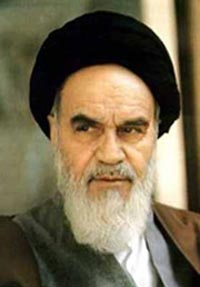 The devastating 1980-1988 Iran-Iraq War heavily influenced Ayatollah Khomeini’s decision to re-start Iran’s nuclear program. The war prompted leading political figures to call for Iran’s development of a nuclear deterrent, demands that were bolstered by its fear of the United States and growing evidence of a covert Iraqi nuclear weapons program. A 2009 internal IAEA working document reports that in April 1984, then President Ali Khamenei announced to top Iranian officials that Khomeini had decided to launch a nuclear weapons program as the only way to secure the Islamic Revolution from the schemes of its enemies, especially the United States and Israel.
The devastating 1980-1988 Iran-Iraq War heavily influenced Ayatollah Khomeini’s decision to re-start Iran’s nuclear program. The war prompted leading political figures to call for Iran’s development of a nuclear deterrent, demands that were bolstered by its fear of the United States and growing evidence of a covert Iraqi nuclear weapons program. A 2009 internal IAEA working document reports that in April 1984, then President Ali Khamenei announced to top Iranian officials that Khomeini had decided to launch a nuclear weapons program as the only way to secure the Islamic Revolution from the schemes of its enemies, especially the United States and Israel. Iran began developing a gas centrifuge program in 1985, according to IAEA reports but realized that it needed foreign assistance to make progress on centrifuges. Iranians visited potential suppliers abroad in order to acquire and learn how to operate key centrifuge equipment. In 1987, Iran acquired key components from the A.Q. Khan network, a rogue nuclear supply network operating out of Pakistan’s state-run nuclear weapons program. The components included:
- A starter kit for a gas centrifuge plant
- A set of technical drawings for a P-1 (Pakistani) centrifuge
- Samples of centrifuge components
- And instructions for enriching uranium to weapon-grade levels. (Weapon-grade uranium is the most desirable highly enriched uranium for fission nuclear weapons and is over 90 percent enriched.)
Phase four: Enrichment and procurement 1988-2002
Iran made deliberate, steady progress in its quest to achieve the full nuclear fuel cycle. It advanced its uranium mining infrastructure, uranium conversion capabilities, indigenous heavy water reactor and associated heavy water production plant, and uranium enrichment programs. In 1990, Iran and China signed a nuclear cooperation agreement. In 1991, Iran secretly imported from China one metric ton of uranium hexafluoride (UF6), which it was obligated under its IAEA safeguards agreement to report to the Agency, but did not. Uranium hexafluoride is the feed gas for gas centrifuges and is difficult to make. Between 1994 and 1996, Iran also purchased from the A.Q. Khan network design drawings and components for 500 P-1 centrifuges, according to the IAEA. It received drawings for the more sophisticated P-2 centrifuge from the network in 1995 but claimed that it did not start work on the P-2 until 2002.
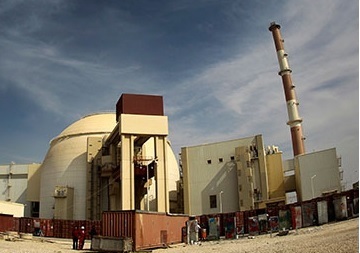 In early 1995, Russia began reconstructing one of the reactors at Bushehr, which had been badly damaged during the Iran-Iraq War. The United States persuaded Russia to halt its negotiations to sell Iran a centrifuge enrichment facility. Russian companies also provided technical assistance in designing a heavy water reactor that Iran was planning at Arak, but U.S. pressure succeeded in convincing Russia to halt cooperation on this venture in the late 1990s. Nonetheless, Iran received significant reactor and fuel design assistance from Russian entities. After years of delay, the Bushehr reactor was started in 2010 and will be under IAEA safeguards, with Russia providing the fuel and taking it back.
In early 1995, Russia began reconstructing one of the reactors at Bushehr, which had been badly damaged during the Iran-Iraq War. The United States persuaded Russia to halt its negotiations to sell Iran a centrifuge enrichment facility. Russian companies also provided technical assistance in designing a heavy water reactor that Iran was planning at Arak, but U.S. pressure succeeded in convincing Russia to halt cooperation on this venture in the late 1990s. Nonetheless, Iran received significant reactor and fuel design assistance from Russian entities. After years of delay, the Bushehr reactor was started in 2010 and will be under IAEA safeguards, with Russia providing the fuel and taking it back.In 1999 and 2002, Iran conducted tests on centrifuges installed at Kalaye Electric Company, its secret centrifuge R&D facility, using the Chinese-supplied UF6. These tests constituted violations of Iran’s safeguards agreements, or violations of Iran’s verification requirements under the NPT. In 2001, again in secret, Iran began constructing a vast underground enrichment facility near the city of Natanz. In 2002, the National Council of Resistance of Iran held a press conference in Washington, D.C. to disclose secret nuclear activities taking place at Natanz and Arak, and revealed the names of entities and officials involved with the nuclear program. The Institute for Science and International Security (ISIS) located these sites and released satellite imagery of both Natanz and Arak in December 2002. ISIS identified Natanz as a gas centrifuge facility.
Iran continued its work on nuclear weapons capabilities throughout the 1990s and early 2000s, making substantial progress on learning to build crude nuclear explosives. It also made progress on miniaturizing nuclear warheads for deployment on ballistic missiles.
Phase five: Investigations, diplomacy and sanctions 2003-2009
The IAEA visited Iran’s newly disclosed nuclear facilities in February 2003 following substantial international pressure for Iran to open its facilities to inspection. The Natanz above-ground pilot enrichment plant could hold 1,000 centrifuges, while its underground halls were equipped to hold 50,000. The agency also inspected the heavy water production facility at Arak.
Britain, France, and Germany, referred to as the EU-3, succeeded in the fall of 2003 in persuading Iran to verifiably suspend its uranium enrichment activities and implement the NPT’s Additional Protocol. These two measures significantly strengthened the IAEA’s ability to inspect Iran’s nuclear program and ensure that it did not have secret nuclear sites. In 2004, Iran and the EU-3 signed the Paris Agreement, which extended the temporary suspension of Iran’s nuclear activities, pending negotiations of long-term arrangements.
In secret, Iran suspended its work on nuclear weapons in 2003. Work on certain aspects of nuclear weapons development, however, may have continued afterwards, according to the IAEA.
 Iran’s suspension of its centrifuge activities lasted for three years, and then Iran restarted its gas centrifuge program and the manufacturing of centrifuges. It also resumed operations at the Isfahan uranium conversion facility that makes uranium hexafluoride. It stopped voluntarily implementing the Additional Protocol in 2006, and refused to answer satisfactorily the IAEA’s questions about past or ongoing experimentation on nuclear weaponization and the development of nuclear warheads for missile delivery systems.
Iran’s suspension of its centrifuge activities lasted for three years, and then Iran restarted its gas centrifuge program and the manufacturing of centrifuges. It also resumed operations at the Isfahan uranium conversion facility that makes uranium hexafluoride. It stopped voluntarily implementing the Additional Protocol in 2006, and refused to answer satisfactorily the IAEA’s questions about past or ongoing experimentation on nuclear weaponization and the development of nuclear warheads for missile delivery systems. In mid-2009, the United States joined the EU-3 in diplomatic negotiations with Iran, after years of refusing to do so. These negotiations did not produce a breakthrough. In September 2009, the leaders of the United States, France, and Britain publicly revealed the existence of a secret uranium enrichment site being built underground near the holy city of Qom. The facility’s revelation prompted concern that Iran intended to construct a potential breakout facility where it could quickly make weapon-grade uranium for a bomb. Iran agreed to place the facility under IAEA safeguards.
Against the backdrop of diplomatic negotiations, the U.N. Security Council passed four rounds of economic sanctions against Iran between 2006 and 2010 for its failure to suspend enrichment and cooperate adequately with the IAEA. The sanctions targeted entities and officials associated with the nuclear program, and Iran’s illicit banking, shipping, and trading activities that supported its nuclear program.
Phase six: International tensions 2010 - 2012
Despite increasing sanctions, Iran refused to halt its enrichment program, and expanded work at Natanz and Fordo. It installed more advanced centrifuges capable of producing enriched uranium more quickly at Natanz and increased the level of enrichment at the Natanz pilot plant and the Fordo enrichment site. In 2010, Iran began enriching its 3.5 percent uranium to 20 percent at the Natanz pilot plant, purportedly for use in fueling the Tehran Research Reactor. Suspicions were that the underlying motivation was to learn to enrich even further, to 90 percent, or weapon-grade. In mid-2011, Iran started producing up to 20 percent enriched uranium at the Fordo plant, creating further tensions.
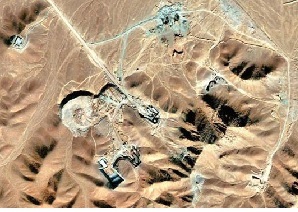 International efforts stalled in 2009 to broker a deal in which Iran would send most of its 3.5 percent enriched uranium out of the country, in return for 20 percent enriched fuel from abroad. This deal would have obviated the need for Iran to make 20 percent uranium. The United States proposed this deal as a way to build confidence in negotiations and extend the timeline of Iran acquiring the capability to make enough weapon-grade uranium for a nuclear weapon.
International efforts stalled in 2009 to broker a deal in which Iran would send most of its 3.5 percent enriched uranium out of the country, in return for 20 percent enriched fuel from abroad. This deal would have obviated the need for Iran to make 20 percent uranium. The United States proposed this deal as a way to build confidence in negotiations and extend the timeline of Iran acquiring the capability to make enough weapon-grade uranium for a nuclear weapon. In mid-2010, most estimates put Iran six to 12 months away from being able to produce enough weapon-grade uranium to build a nuclear weapon, if it decided to do so. It would take longer to make the nuclear explosive itself. In late 2011, the IAEA released a report containing areas of outstanding concern it had over Iran’s military nuclear programs based on evidence that Iran had worked on nuclear weaponization and the development of a missile delivery payload system. The IAEA and member states called on Iran to address the IAEA’s concerns. Iran, however, dismissed the evidence as forgery or invention. The IAEA believed Iran acquired sufficient information to design and produce a workable implosion nuclear device based on highly enriched uranium as the fission fuel. A high-explosive implosion system developed by Iran could be contained within a payload container small enough to fit into the re-entry body chamber of the Shahab-3 missile. The IAEA did not believe that Iran had achieved the means to integrate a nuclear payload into the Shahab-3.
International discussion about the merits of a strike on Iran’s nuclear facilities by Israel, the United States, or some combination of countries occurred, at odds with those favoring sanctions or engagement to induce Iran to change its apparent course. The United States and European Union introduced strong, targeted financial and oil sector sanctions against Iran in order to bring it to negotiate an end to the crisis and prevent it from building nuclear weapons. Iran’s economy was under ever increasing pressure. Between 2009 and 2013, the United States and Iran held back channel talks over the possibility of nuclear negotiations. They soon reached a critical turning point.
Phase seven: International engagement 2013 - 2015
In 2013, the controversial presidency of Mahmoud Ahmadinejad concluded with the election of more moderate candidate Hassan Rouhani. After years of back channel talks with the United States and weathering stronger sanctions, Iran was more willing to negotiate by the time Rouhani took office. In November 2013, Iran and the P5+1 announced the Joint Plan of Action, an agreement that limited and froze portions of Iran’s nuclear programs and introduced greater transparency while a longer term agreement could be negotiated. The parties later reached the Lausanne framework agreement on April 2, 2015 which spelled out several steps for a comprehensive agreement.
On July 14, 2015, Iran and the P5+1 announced the Joint Comprehensive Plan of Action (JCPOA). This agreement will suspend and finally remove key sanctions on Iran. In return, Iran will limit its nuclear program, address questions regarding past nuclear weapons related efforts, and enhance the ability of inspectors to detect undeclared nuclear work by implementing the Additional Protocol. The JCPOA also references a simultaneously developed Iran/IAEA Roadmap which will seek to resolve the possible military dimensions to Iran’s nuclear programs by December 2015. The JCPOA will begin at Implementation Day, expected to be in mid-2016, after a series of steps by Iran to limit its nuclear programs and fulfill the IAEA Roadmap in order to remove sanctions.
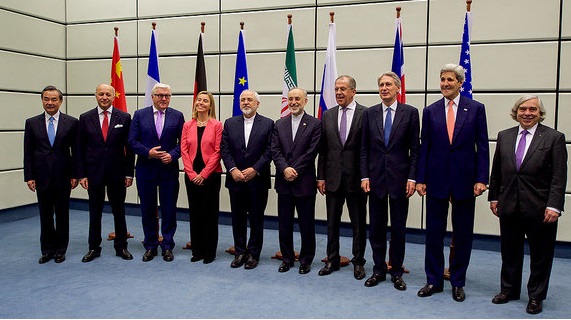
Five key strengths of the JCPOA include:
1) Lengthening of Iran’s ”breakout time” from roughly one to two months as of late 2013 to seven to 12 months during the first ten years of the deal;
2) Limits on the growth of Iran’s nuclear enrichment program for 10 years due to: maintenance of limited low-enriched uranium (LEU) stockpiles, no enrichment over 3.67 percent allowed, and limits on advanced centrifuge development;
3) Blockage of the plutonium production pathway for 15 years through a re-design of Arak reactor, no production of heavy water, and no plutonium reprocessing allowed during this period;
4) Regulation of Iran’s nuclear related imports for 10 years through a U.N. mandated procurement channel; and
5) Enhanced transparency and verification of Iran’s nuclear program through its implementation of the Additional Protocol, a binding IAEA access provision to sites suspected of secret nuclear activities, and a parallel process for settling the IAEA’s concerns about the possible military dimensions to Iran’s nuclear program.
Five key weaknesses of the JCPOA include:
1) A quick return to shortened breakout timelines after year 10, decreasing from six months at year 13 to just days or weeks by year 15 as Iran deploys advanced centrifuges and caps on enrichment levels and LEU stockpiles come off, and possibly renewed international and regional concern over this future;
2) Limitations on Iran’s nuclear related imports end at year 10 just as breakout timelines start to decrease, meaning Iran’s nuclear program can import more freely a wide range of goods, making covert activities more difficult to observe. In addition, the procurement channel is complicated and is expected to be difficult to implement and enforce;
3) No intermediate penalties are outlined in the JCPOA for responding to minor problems or violations by Iran of its commitments. Most U.N. and national sanctions will be removed at the start of the agreement and only their full “snapback” is designated to deal with issues of noncompliance. This means that the deal would likely be terminated by Iran over a P5+1 decision to escalate to snapback, thus the P5+1 may accept less than full compliance by Iran in order to avoid this. Leverage for ensuring Iranian compliance is thus far from certain;
4) The scope and manner of the investigation agreed to by the IAEA and Iran over PMD is unknown publicly. It is not known whether the PMD investigation will be as in-depth as past IAEA standards, including whether the IAEA will know enough to reach a conclusion on a past nuclear weapons program, or whether comprehensive inspections of suspect sites and interviews will occur;
5) Iran could deny the IAEA access to sites, information, or individuals, stating that they are military in nature, which could allow Iran to conduct covert nuclear activities. The P5+1 may tolerate refusals to cooperate or grant access, or even a weakened inspection arrangement, in order to keep the deal from collapsing. Iran is also not explicitly required to ratify the Additional Protocol by year 8, or Transition Day. It is unclear what happens if it does not, but the risk is that Iran could try to limit access and transparency past year 8 depending on the parties’ interpretations and actions.
Factoids
- Natanz: The Natanz Fuel Enrichment Plant has had 9,156 IR-1 centrifuges enriching, and 15,420 IR-1 centrifuges installed since November 2013 when the interim agreement (JPOA) was agreed. Under the final deal (JCPOA), Iran will only be allowed to operate 5,060 IR-1 centrifuges at Natanz and enrich uranium up to 3.67 percent for 15 years.
- Fordo: The Fordo plant in Qom had 696 centrifuges that were enriching uranium to 19.75 percent up until the JPOA went into force in January 2014. Since then, the Fordo plant’s centrifuges have enriched uranium only up to five percent. The plant was capable of housing 2,976 centrifuges until its expansion was frozen by the JPOA. Under the JCPOA, the Fordo facility will be converted into a nuclear, physics, and technology research center and will operate 1,044 IR-1 centrifuges in six cascades, which will not enrich uranium for a period of fifteen years. To many critics, one of the failings of the deal is that this plant was not shut down. After year 15 of the deal, it can resume enriching uranium in advanced centrifuges, up to 15 times more powerful than the current ones.
- 3.5 Percent LEU Inventory: Based on data in the August 2015 IAEA Iran safeguards report, Iran has a total inventory of 7,845.4 kg of 3.5 percent LEU hexafluoride and the equivalent of another 4,304 kg of 3.5 percent LEU hexafluoride in various chemical forms at its Enriched UO2 Powder Plant (EUPP). In total, Iran thus has the equivalent of 12,149 kg of 3.5 percent LEU hexafluoride. Under the JCPOA, Iran has agreed to remove or blend down all but 300 kg of this 3.5 percent LEU hexafluoride equivalent.
- Decreasing 20 Percent LEU stockpile: Iran has not been allowed to produce 19.75 percent LEU since the interim JPOA took effect and is required to downblend half this stock to 3.5 percent LEU and convert the other half to oxide form, a process it was still completing as of September 2015. While the Natanz Pilot Fuel Enrichment Plant produced 20 percent LEU, in total, Iran produced 202 kg of 19.75 percent enriched uranium since the beginning of operations in February 2010. In total, while it was producing 20 percent LEU, the Fordo facility produced 245.9 kg of near 20 percent LEU hexafluoride from 1,806 kg of 3.5 percent LEU hexafluoride. Almost all of this near 20 percent LEU is supposed to leave Iran under the long-term deal.
- Breakout: The capping of Iran’s enrichment capabilities under the JCPOA will lengthen breakout timelines substantially, to roughly seven to 12 months. (The range reflects differences over whether it can redeploy its IR-2m centrifuges slated for dismantlement). After year 10, Iran will be allowed to deploy advanced centrifuges, reducing breakout timelines to about six months by year 13. After year 15 of the agreement, breakout timelines can reach as little as a few days with enrichment in advanced centrifuges and the removal of the cap on the 3.67 percent LEU and resumed production of near 20 percent LEU.
- Plutonium: The JCPOA prevents Iran from separating or reprocessing plutonium or acquiring heavy water reactors for 15 years. This provision intends to block Iran’s plutonium pathway to nuclear weapons using its Arak reactor.
- Possible military dimensions: Iran will address PMD as mandated by the JCPOA under a separate arrangement with the IAEA called a Roadmap. The IAEA will issue a final report on the matter by December 2015. It will then seek a broader conclusion under the Additional Protocol procedures about the peacefulness of Iran’s fissile material related nuclear activities.
- Procurement: The JCPOA establishes a procurement channel for Iran to legally acquire goods for its nuclear programs.
- Site access: The JCPOA creates a binding mechanism of 24 days to authorize access to a site in Iran sought by the IAEA due to reported suspicious activities.
- More transparency: Iran will provisionally implement the Additional Protocol and seek ratification at year 8 or Transition Day.
- Sanctions: Iran will receive relief from all United Nations nuclear related sanctions at Implementation Day of the JCPOA if it undertakes its nuclear measures. The European Union and United States will terminate or suspend their nuclear, financial, oil, and related sanctions against Iran at Implementation Day.
Individuals or organizations
Atomic Energy Council (AEC): Iran’s general nuclear policy is directed by the AEC, which was created by the same law that created the Atomic Energy Organization of Iran in 1974.
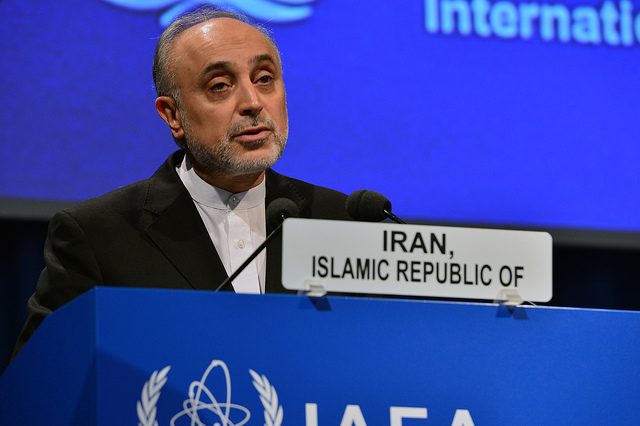 Atomic Energy Organization of Iran (AEOI): The AEOI was established in 1974 to oversee Iran’s civil nuclear program. It also oversaw Iran’s clandestine nuclear activities.
Atomic Energy Organization of Iran (AEOI): The AEOI was established in 1974 to oversee Iran’s civil nuclear program. It also oversaw Iran’s clandestine nuclear activities.Field for Expansion of Advanced Technologies’ Deployment (FEDAT): This is reportedly the most current name of the sector that worked on Iran’s clandestine nuclear weapons-related activities.
Ministry of Defense: The IAEA believes the ministry played an active role in the development of a nuclear payload for the Shahab-3 missile.
Supreme leader: Ayatollah Ali Khamenei has ultimate say over Iran's nuclear program, and all major decisions on the nuclear issue require his approval.
Supreme National Security Council (SNSC): The SNSC is concerned mainly with defense and national security policies. Key nuclear decisions are dominated by the supreme leader and a relatively small group of senior leaders and advisors, including those in the Supreme National Security Council.
Trendlines
- The size of Iran’s sensitive nuclear programs will decrease substantially under the JCPOA.
- The JCPOA’s fundamental goal is to ensure that Iran’s nuclear program is peaceful even after its major nuclear limitations end. For 10 years, this agreement creates conditions that will make any serious effort by Iran to build nuclear weapons highly time consuming and vulnerable to detection. Whether the deal meets the goal of preventing Iran from building nuclear weapons in the long term is more doubtful. This uncertainty poses one of the more fundamental challenges to the agreement.
- There remain significant concerns that Iran will not address the IAEA’s PMD concerns before Implementation Day and such a failure will impact negatively the success of the agreement. The investigation may not delve deeply into resolving the issues, and the PMD provisions may be left to interpretation by the IAEA and the P5+1 that is not clear to publics and many governments.
- A set of intrusive verification measures, such as the Additional Protocol, will remain in place after year 15 of the deal, but they may not be sufficient to stop Iran from obtaining nuclear weapons. Armed with a large centrifuge program, an Iranian attempt to break out to nuclear weapons would be detected— but probably not in time to take action to prevent it. Iran’s breakout time could reach just days after year 15 of the agreement, based on its stated plans to grow its enrichment program to industrial levels.
- The JCPOA has many strengths that could temporarily resolve the Iranian nuclear issue due to the limits on Iran’s nuclear growth, assuming it abides by the provisions. Implementation, however, may be difficult throughout its duration given past Iranian covert nuclear work, failures to abide by agreements, violations of trade controls and sanctions, and pushing against restrictions. Moreover, whether or not it succeeds after most limitations end will depend on Iran’s actions that are difficult to predict. Therefore planning for and preventing shortened breakout timelines and a potentially renewed nuclear crisis after the deal ends is critical.
David Albright, a physicist and former U.N. weapons inspector, is the president and founder of the Institute for Science and International Security (ISIS) in Washington, D.C. Andrea Stricker is a senior policy analyst at the Institute for Science and International Security (ISIS).
Photo credits: Mohammad Reza Shah Pahlavi via Wikimedia Commons [public domain]; Khomeini via Khamenei.ir; Bushehr via NuclearEnergy.ir, Natanz via Iranian President's Office and The New York Times; Fordo via NuclearEnergy.ir; P5+1 foreign ministers via U.S. State Department; Ali Akbar Salehi by IAEA Imagebank via Flickr [CC BY-SA 2.0].
This chapter was originally published in 2010, and is updated as of September 2015.
